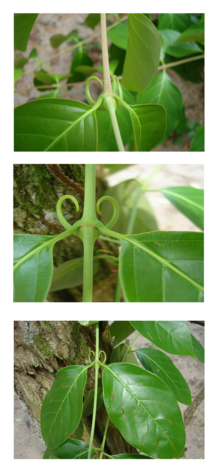
Back ጸጉራም ድመት-ጥፍር Amharic مخالب القط Arabic مخالب القط ARZ Uncaria tomentosa AST Wilkakora Aymara Keçətük unkariya Azerbaijani Котешки нокът Bulgarian Uncaria tomentosa Catalan Uncaria tomentosa CEB Řemdihák plstnatý Czech
| Uncaria tomentosa | |
|---|---|

| |
| Scientific classification | |
| Kingdom: | Plantae |
| Clade: | Tracheophytes |
| Clade: | Angiosperms |
| Clade: | Eudicots |
| Clade: | Asterids |
| Order: | Gentianales |
| Family: | Rubiaceae |
| Genus: | Uncaria |
| Species: | U. tomentosa
|
| Binomial name | |
| Uncaria tomentosa | |
Uncaria tomentosa is a woody vine found in the tropical jungles of South and Central America. It is known as cat's claw or uña de gato in Spanish because of its claw-shaped thorns.[1][2] The plant root bark is used in herbalism for a variety of ailments, and is sold as a dietary supplement.[2][3][4]
Evidence of anti-inflammatory action is limited to cell culture studies.[5][6] and has not been demonstrated in randomized control human trials.[citation needed] Cat's claw is being studied for a number of other possible uses, including HIV, Crohn disease, multiple sclerosis, systemic lupus erythematosus (SLE or lupus), endometriosis, kidney problems, bladder cancer, and Alzheimer disease. More research is needed before scientists can say whether it is effective.[7][8]
- ^ a b "Uncaria tomentosa". Germplasm Resources Information Network. Agricultural Research Service, United States Department of Agriculture. Retrieved 2008-03-01.
- ^ a b "Cat's claw". Drugs.com. 6 September 2021. Retrieved 16 August 2022.
- ^ "Assessment report on Uncaria tomentosa (Willd. ex Schult.) DC., cortex" (PDF). European Medicines Agency. 10 March 2015. Retrieved 11 January 2019.
- ^ "Cat's claw". National Center for Complementary and Integrative Health, US National Institutes of Health. 1 May 2020. Retrieved 17 August 2022.
- ^ Sandoval-Chacón, M; Thompson, JH; Zhang, XJ; Liu, X; Mannick, EE; Sadowska-Krowicka, H; Charbonnet, RM; Clark, DA; Miller, MJ (December 1998). "Antiinflammatory actions of cat's claw: the role of NF-κB". Alimentary Pharmacology & Therapeutics. 12 (12): 1279–1289. doi:10.1046/j.1365-2036.1998.00424.x. PMID 9882039. S2CID 24640166.
- ^ Miller, Mark J. S.; Zhang, Xiao-Jing; Charbonnet, Randi M.; Clark, David A.; Sandoval, Manuel (April 1999). "The Anti-Inflammatory Actions of the Herbal Medicine, Cat's Claw, Are Due to a Suppression of NF-κB Activation and Inhibition of Gene Expression". Pediatric Research. 45 (7): 114. doi:10.1203/00006450-199904020-00676. S2CID 72216843.
- ^ "Cat's claw Information". Mount Sinai Health System.
- ^ Patel, Kamal. "Research Breakdown on Cat's claw". Examine.